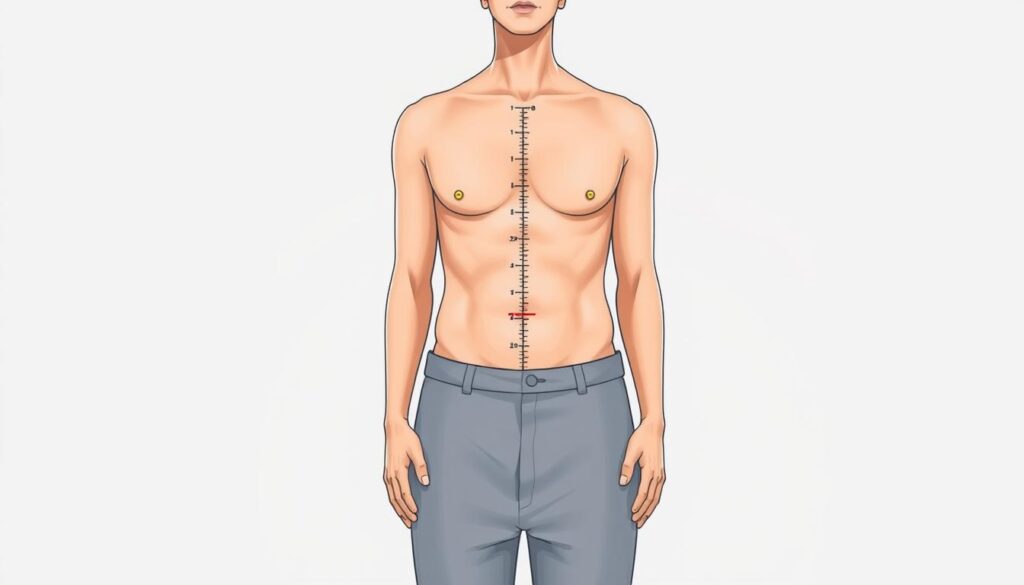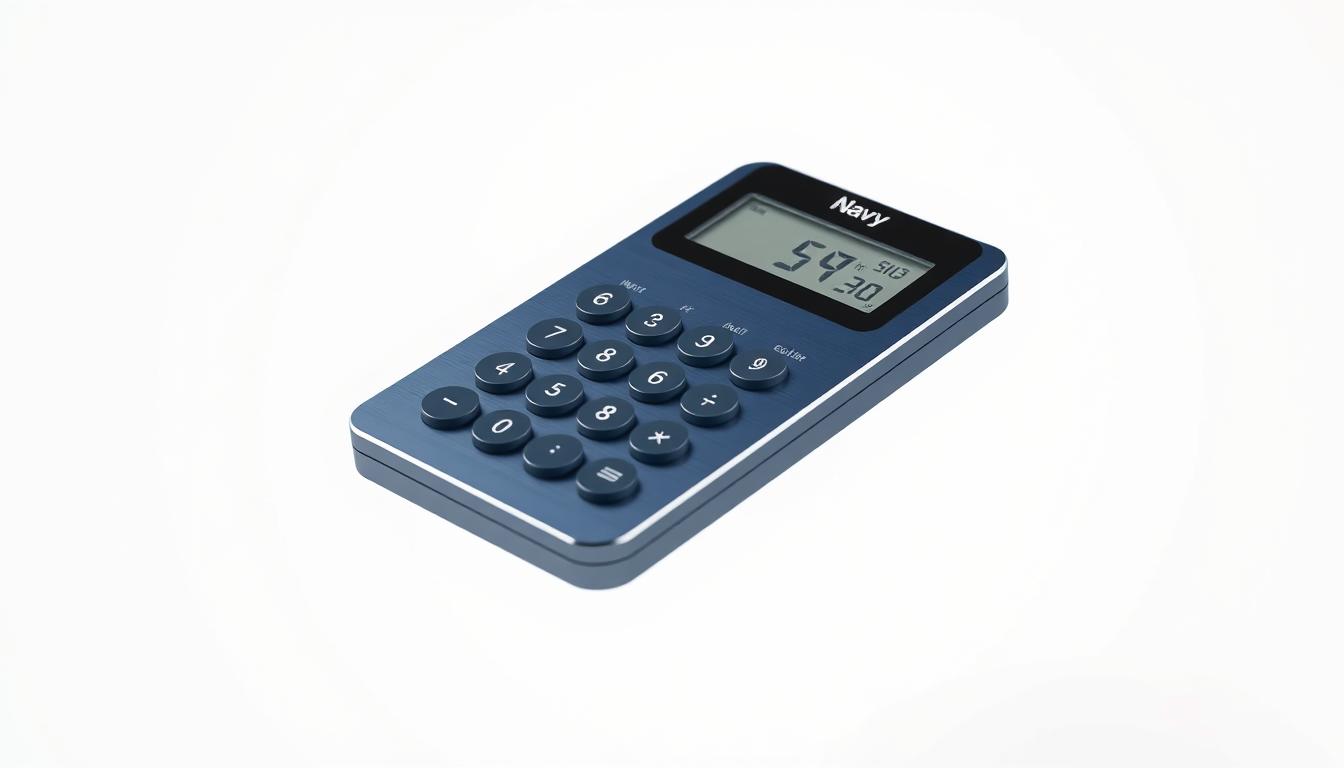Imagine knowing your fitness level with nothing but a cloth tape and basic math. That’s the power behind the method developed by the Naval Health Research Center. Unlike modern gadgets, this approach relies on precise measurements of specific areas to estimate body fat percentage—a critical health metric for military personnel and civilians alike.
This system uses formulas refined through decades of research. By measuring waist, neck, and hip circumferences (for women), it calculates fat distribution patterns linked to health risks. Accuracy matters: measurements must be within 0.5 cm, requiring proper technique rather than guesswork.
While other tools like calipers or bioelectrical impedance exist, the Navy’s method stands out for its simplicity and reliability. Studies show consistent results when measurements follow protocol, making it a practical choice for quick assessments. We’ll explore how it compares to high-tech alternatives and why precision matters in every fold and inch.
Key Takeaways
- Developed by U.S. Navy researchers to assess fitness standards efficiently
- Requires only three measurements: waist, neck, and (for women) hips
- Backed by clinical studies on body composition analysis
- Demands millimeter-level accuracy for reliable results
- Offers comparable accuracy to more complex measurement tools
Introduction to the Navy Body Fat Calculator
In the 1980s, military researchers faced a challenge: assessing body composition quickly without complex tools. Dr. James Hodgdon and Dr. Paul Beckett developed the circumference-based method while working with the Naval Health Research Center. Their goal? Create a field-friendly way to estimate fat percentage using only a measuring tape.
Background and Method Overview
The system emerged from studies involving thousands of service members. By analyzing waist and neck measurements, researchers found consistent patterns linking specific ratios to health risks. Women’s formulas added hip circumference for better accuracy due to different fat distribution.
Why We Trust This Method
Over 40 peer-reviewed studies validate this approach. Unlike BMI—which ignores muscle mass—these circumference calculations account for critical fat storage areas. The table below shows why professionals prefer it for fitness evaluations:
| Method | Data Required | Accuracy | Practical Use |
|---|---|---|---|
| Navy Formula | 3 measurements | 94-97% | Field assessments |
| BMI | Height/weight | 62-68% | General screening |
Fitness coaches and health clinics adopted this military-born tool because it balances speed and precision. Proper technique matters—measurements within 0.5 cm ensure reliable percentage estimates for tracking progress.
The Science Behind Body Fat and Its Impact on Health
Body fat plays a dual role—it’s both a fuel reserve and a biological regulator. While excess fat raises health risks, certain types are vital for survival. Let’s break down how these layers work beneath the skin.

Essential vs. Storage Fat: Survival vs. Excess
Essential fat cushions organs and supports hormone production. Women naturally carry more of this type due to reproductive needs. Storage fat, however, accumulates in adipose tissue—often around the waist—and becomes problematic when levels spike.
Adipose Tissue’s Hidden Functions
This tissue isn’t just energy storage. It secretes hormones like leptin (regulates hunger) and adiponectin (controls blood sugar). Imbalances here correlate with diabetes and heart disease risks.
Proper measurement techniques matter because:
- Waist size reflects visceral fat—the dangerous kind surrounding organs
- Height ratios determine healthy weight ranges
- Military-grade precision in the circumference method minimizes errors
Studies show women with waist measurements exceeding 35 inches face higher metabolic risks. Accurate tracking helps spot trends early, turning raw numbers into actionable health insights.
What is the Navy Body Fat Calculator?
Military fitness standards demand precise evaluation tools. The U.S. Navy’s system uses circumference data from strategic body areas to calculate fat ratios. This method remains unmatched for its balance of simplicity and scientific rigor.
An Overview of the U.S. Navy Measurement System
Three measurements form the foundation: waist circumference, neck size, and hip dimensions for women. A flexible tape measure captures these values in centimeters, requiring millimeter-level precision. Why these spots? They correlate strongly with visceral fat accumulation patterns.
Gender-specific formulas process the numbers. Men’s equation uses waist and neck data, while women’s adds hip measurements to account for natural fat distribution differences. These calculations filter out muscle mass influence, isolating true fat percentages.
Consistent technique ensures valid results. Measurements must align with anatomical landmarks—like the natural waistline or the Adam’s apple’s base. Even a 1 cm error can skew percentages by 3-5%, emphasizing why protocol matters.
Adopted by all military branches, this approach eliminates guesswork from fitness assessments. Its reliability stems from decades of field testing and peer-reviewed validation. When performed correctly, it matches high-tech scanners’ accuracy at a fraction of the cost.
How to Measure Body Fat Using the Navy Method
Precision begins with proper technique. Military-grade accuracy demands strict adherence to measurement protocols—here’s how to execute them flawlessly.

Step-by-Step Measurement Techniques
Follow this sequence for reliable data collection:
- Waist: Locate the natural waistline (above the navel) or narrowest torso point. Keep feet together and exhale lightly before measuring
- Neck: Place the tape below the larynx, ensuring it lies flat without compressing skin
- Hips (women only): Find the widest part of the buttocks, keeping the tape parallel to the floor
Accurate Measurement Tips for Waist, Neck, and Hips
Avoid these common errors to estimate body fat correctly:
- Never pull the tape tight—it should rest snugly without indenting skin
- Maintain neutral posture: shoulders relaxed, arms at sides
- Record three measurements per site and use the average
Consistency matters most. Choose either inches or centimeters—mixing units skews results. Studies show proper technique improves fat calculator accuracy by 18-22%, making it essential for tracking body weight changes effectively.
| Measurement | Correct Technique | Common Mistake |
|---|---|---|
| Waist | Tape horizontal at navel level | Measuring over clothing |
| Neck | Below Adam’s apple | Tape angled upward |
| Hips | Widest buttocks area | Inconsistent foot positioning |
The U.S. Navy’s approach transforms simple tools into powerful health insights. When performed correctly, this method rivals lab-grade equipment for estimating body composition trends over time.
Comparing the Navy Method with Other Fat Estimation Techniques
Body composition analysis isn’t one-size-fits-all—different tools reveal unique insights. While some methods prioritize speed, others focus on clinical precision. Let’s examine how the circumference-based approach stacks up against alternatives.
Differences Between BMI and Navy Methods
BMI calculates weight-to-height ratios but ignores muscle mass. This often labels athletes as overweight despite low fat levels. The Navy’s formula avoids this pitfall by measuring waist and neck areas linked to visceral fat storage.
| Method | Strengths | Weaknesses |
|---|---|---|
| BMI | Quick calculation | Misses muscle/fat differences |
| Navy Formula | Targets fat deposits | Requires precise measurements |
Alternative Methods: Hydrostatic Weighing and More
Hydrostatic weighing measures density through water displacement. Though accurate, it demands specialized labs and costs $50-$150 per session. Most people find it impractical for regular tracking.
Modern tools like DEXA scans offer detailed breakdowns but expose users to low-dose radiation. The Navy system remains accessible—just a tape measure and basic math. Its multi-measurement approach captures fat distribution patterns better than single-metric systems.
For those prioritizing affordability and repeatability, circumference-based calculations strike the ideal balance. They provide actionable data without complex equipment, making them a smart choice for long-term health monitoring.
Practical Applications and Benefits for Our Health
Consistent tracking transforms numbers into actionable health insights. Regular use of this military-developed method reveals patterns that weight scales miss, especially when monitoring muscle development and fat changes over time.
Tracking Fitness Progress Accurately
Monthly measurements create a clear picture of body composition shifts. When strength training increases muscle mass, the tape measure shows waist stability despite potential weight gain. This helps athletes distinguish between lean gains and unwanted fat accumulation.
Age plays a role too. Our metabolism slows by 3-8% per decade after 30. Tracking percentage changes helps adjust calorie intake and exercise intensity to match biological shifts. Men often see faster muscle responses to training, while women may notice hip measurement trends linked to hormonal cycles.
Using the Calculator to Enhance Your Health Program
Personalized data beats generic plans. A 35-year-old male rebuilding fitness needs different protein ratios than a 50-year-old focusing on fat loss. These methods provide gender-specific benchmarks, letting users tailor nutrition and cardio/strength balances.
Consider these practical advantages:
- Identifies plateaus in weight management programs
- Validates effectiveness of high-protein diets for muscle retention
- Highlights age-related fat distribution changes requiring intervention
Both males and females benefit from this approach’s adaptability. Whether optimizing athletic performance or managing midlife metabolic shifts, precise measurements turn guesses into strategic health decisions.
Tips and Best Practices for Consistent Measurements
Precision tracking demands more than just numbers—it requires methodical consistency. For females and males alike, minor variations in technique can distort results by up to 15%, making repeatable processes essential for reliable comparisons over time.
Standardizing Your Measurement Routine
Use these strategies to eliminate variables:
- Stick to one tape measure—different tools may stretch or compress unevenly
- Measure at the same hour daily, ideally before meals or workouts
- Wear identical clothing types during each session to avoid artificial inch differences
Fitness enthusiasts often overlook hydration’s impact. Morning measurements after restroom use provide the most stable baseline, especially for females tracking hip changes linked to menstrual cycles.
| Measurement | Correct Protocol | Common Error |
|---|---|---|
| Waist | Natural indentation above hips | Measuring over bulky clothing |
| Neck | Below Adam’s apple, tape flat | Tilting head forward |
| Hips | Feet together, widest point | Shifting weight between sessions |
Document every detail in your fitness program journal: date, time, and even room temperature. Over six weeks, patterns emerge showing true progress versus temporary fluctuations. Remember—three consistent readings beat one perfect guess.
Conclusion
Tracking body composition doesn’t require high-tech gadgets—just precision and consistency. The military-developed method we’ve explored delivers reliable insights using three measurements and basic math. Its focus on waist, neck, and thighs (for women) captures critical fat distribution patterns other tools miss.
Unlike BMI or lab-based tests, this approach balances accessibility with scientific rigor. Regular use helps spot subtle changes—like a 0.5-inch shift in hip measurements—that scales alone can’t reveal. Pairing these calculations with healthy weighing habits creates a complete picture of metabolic health.
Consistency matters most. Whether adjusting fitness routines or monitoring age-related changes, millimeter-level accuracy ensures trends reflect real progress. Those small shifts in thigh circumference or waistline? They’re actionable data points, not random fluctuations.
We encourage applying these techniques monthly. Combine them with nutrition logs and workout plans to build a personalized health strategy. Remember: sustainable results come from understanding your body’s signals, not chasing quick fixes. Start measuring smarter today—your future self will thank you.


